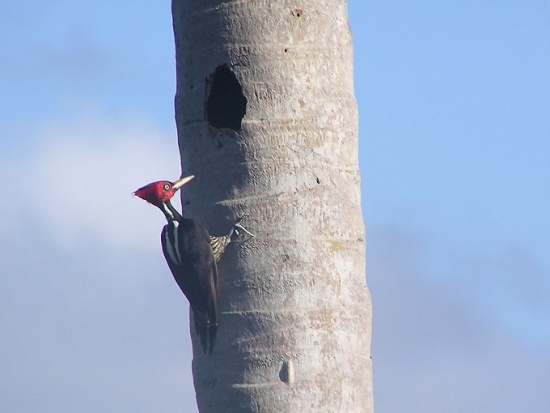Nomdeploom (talk | contribs) m (Add genus tags) |
(taxonomy, refs, caption) |
||
| Line 1: | Line 1: | ||
| + | [[Image:Pale-billed_Woodpecker.jpg|thumb|550px|right|Photo by {{user|Leslie|Leslie}}<br />Sayulita, [[Mexico]], October 04]] | ||
;[[:Category:Campephilus|Campephilus]] guatemalensis | ;[[:Category:Campephilus|Campephilus]] guatemalensis | ||
| − | |||
==Identification== | ==Identification== | ||
| Line 10: | Line 10: | ||
Northern [[Mexico]] to western [[Panama]]. | Northern [[Mexico]] to western [[Panama]]. | ||
==Taxonomy== | ==Taxonomy== | ||
| + | Three subspecies are recognized: | ||
| + | *''nelsoni'' | ||
| + | *''regius'' | ||
| + | *''guatemalensis'' | ||
| + | The first two are only found in Mexico. | ||
==Habitat== | ==Habitat== | ||
Wet forests and adjacent second growth or semi-open woodland. | Wet forests and adjacent second growth or semi-open woodland. | ||
| Line 15: | Line 20: | ||
Two white eggs are laid in an unlined nest hole 3-30 m high in a tree and incubated by both sexes. The young hatch naked and are fed by both parents. | Two white eggs are laid in an unlined nest hole 3-30 m high in a tree and incubated by both sexes. The young hatch naked and are fed by both parents. | ||
It chips out holes, often quite large, while searching out insects in trees. Diet is mainly beetle larvae, with some berries or other fruit. | It chips out holes, often quite large, while searching out insects in trees. Diet is mainly beetle larvae, with some berries or other fruit. | ||
| − | + | ==References== | |
| + | # Clements, James F. 2007. ''The Clements Checklist of Birds of the World''. 6th ed., with updates to October 2007. Ithaca: Cornell University Press. ISBN 9780801445019 | ||
| + | {{ref}} | ||
==External Links== | ==External Links== | ||
{{GSearch|Campephilus+guatemalensis}} | {{GSearch|Campephilus+guatemalensis}} | ||
[[Category:Birds]] [[Category: Campephilus]] | [[Category:Birds]] [[Category: Campephilus]] | ||
Revision as of 01:20, 4 January 2010
- Campephilus guatemalensis
Identification
37 cm long and weighs 255g. Similar to the Lineated Woodpecker, but is larger.
The adult is mainly black above with a pale bill, bushy crest, and white lines down the shoulders which almost meet in a V on its back. The throat is black and the rest of the underparts are white, heavily barred with black. The male has a red head and crest; the female is similar, but the crest and throat are black. The female can be distinguished from Lineated Woodpecker by the absence of a white facial stripe.
Distribution
Northern Mexico to western Panama.
Taxonomy
Three subspecies are recognized:
- nelsoni
- regius
- guatemalensis
The first two are only found in Mexico.
Habitat
Wet forests and adjacent second growth or semi-open woodland.
Behaviour
Two white eggs are laid in an unlined nest hole 3-30 m high in a tree and incubated by both sexes. The young hatch naked and are fed by both parents. It chips out holes, often quite large, while searching out insects in trees. Diet is mainly beetle larvae, with some berries or other fruit.
References
- Clements, James F. 2007. The Clements Checklist of Birds of the World. 6th ed., with updates to October 2007. Ithaca: Cornell University Press. ISBN 9780801445019
Recommended Citation
- BirdForum Opus contributors. (2024) Pale-billed Woodpecker. In: BirdForum, the forum for wild birds and birding. Retrieved 26 April 2024 from https://www.birdforum.net/opus/Pale-billed_Woodpecker




